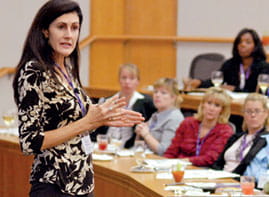6/6/2014 -
When asked why he robbed banks, notorious criminal Willie Sutton allegedly said, “Because that’s where the money is.”
Facing mounting economic pressure to deliver affordable quality care, health care providers and payers may want to heed Slick Willie’s advice, according to Ezekiel Emanuel, MD.
Emanuel, the former special advisor for health policy to the White House and one of the architects of the 2010 Affordable Care Act (ACA), spoke about the changing health care environment and its impact at the June 4 Kellogg MacEachern Symposium, titled “The Future of the Physician.” The Health Enterprise Management Program hosted the event.
Ten percent of the U.S. population—mainly the chronically ill—consumes two-thirds of all health care dollars. To stay in business, hospitals and physicians need to target this group to reduce costs, Emanuel said to a packed house of alumni, students and business community members. Citing data about the approximately eight million Americans who recently shopped the newly-minted public exchanges for health insurance, he shared, “People are cheap and buying mainly on cost. This has very important implications for providers.”
Turning the Queen Mary with a rowboat
Physicians play a key role in the cost-savings equation at the frontlines of care. While many agree that the health system needs resuscitation, implementing the fixes hospitals and payers need is an entirely different matter. Generating quality metrics and electronic record keeping come at a price, and benefits will not increase overnight. “Think of trying to turn around the Queen Mary with a row boat,” said keynote speaker Ardis Dee Hoven, MD, president of the American Medical Association (AMA). “You just simply cannot do it easily. It will take some time.”
The AMA strives to ensure physician satisfaction as they work with health care policymakers in Washington. However, after recently surveying AMA members, the association found that “55 percent would not tell their children to become a physician. That’s frightening,” Hoven said.
A serious problem, physician burnout decreases patient satisfaction and adherence to treatment plans, increasing health care costs in the end, according to Hoven.
Looking ahead
The second half of the symposium featured two panel discussions with questions fielded from the audience. In the first, practitioners and academics provided insight on the current shortage of primary care physicians in the United States. Dean Harrison, president and CEO of Northwestern Memorial HealthCare, said physician extenders such as nurse practitioners and physicians assistants are viable options for freeing up physician time.
As far as an adequate pipeline of general practitioners, Lee Sacks, MD, EVP and CMO of Advocate Health Care and CEO of Advocate Physician Partners, believes that lowered demand for specialists will swing the pendulum back. “More [medical school] graduates are going to go into primary care training because of the economics.”
Additional advancements in care were raised by David Meltzer, MD, of the University of Chicago, pointing to a pilot program in which the same physician provides care to patients both inside and outside the hospital. This intervention focuses on patients with high rates of hospitalizations, and Drs. Meltzer and Sacks emphasized that mental health issues are critical needs that must be addressed to effectively care for these patients.
The all-day conference ended with a forecasting panel on the year ahead in health care. Kellogg’s
Edward Hughes, MD, predicted, “The technical quality of medicine will only improve, improve, improve.”






